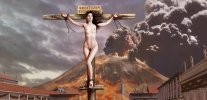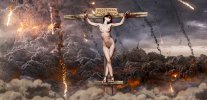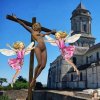'The hot wind raises eddies of ash and slag. An incandescent sandstorm is rushing down from Vesuvius towards Pompeii. The defenceless walls are cracking, roofs exploding, tiles, bricks, beams, stones and human bodies all flying towards me, but in such a slow motion they seem in this long moment to be spinning in the air silhouetted against the dazzling light from the wave of fire, empty entities suspended in mid-air at the level of the roofs, the last image of the outside world, a world of shadow and dust.'
(From 'Amica, the Slavegirl of Pompeii' by Velut Luna.)
Following the detailed research which Eulalia and I have undertaken during the last five months, I have been able to attempt a recreation of Luna's vision of the way she liked to see her personal character portrayed. The prevalence of Aisii's expressive pictures in Luna's threads, as well as the fact that her only manipulation for 'Amica' employs Ana-Maria Ilinca, reveals much about the image with which Luna identified. I also have to thank Eulalia for her consultation and input on many of the new pictures which I have created for this thread, and especially for her views on the development of the crux manips.
I am not aware of any colour version of the source figure of Aisii which Luna employed, but since she was working with a black and white photograph of the 1944 eruption, and she expressed a personal preference for monochrome, she was simply not concerned with the prospect of producing a colour version of the crux scene. However, considering the dramatic nature of this scene, I felt that a colour version was justified. In fact there are now two colour versions based directly on Luna's concept, in addition to detail variations.
Using selective colourisation treatments in Photoshop, the original monochrome features of the volcanic eruption were transformed in slightly muted colours, appropriate for the distant background. The individual components in the picture were subjected to balancing for colour, tone and contrast adjustments, in order to achieve a convincing overall consistency for the backgrounds. The first of these depicts the Temple of Jupiter prior to its collapse during the eruption. Eul and I agreed that the temple obscurs much of the volcano whose sweeping lava flows are such a feature of Luna's visual concept. The issue was addressed by producing the second background, showing the fiery cloud emerging through the temple ruins shortly after its collapse. The two backgrounds are further differentiated by a subtle change in the lighting colour of the remaining buildings.
Once the figure of Amica was colourised, the crux components were subjected to further balancing adjustments to achieve appropriate blending with the backgrounds. Notwithstanding the various treatments in my interpretations, I like to think that these colour pictures remain visibly indebted to Luna's original vision of the crucifixion of Amica.
Last edited by a moderator:



























